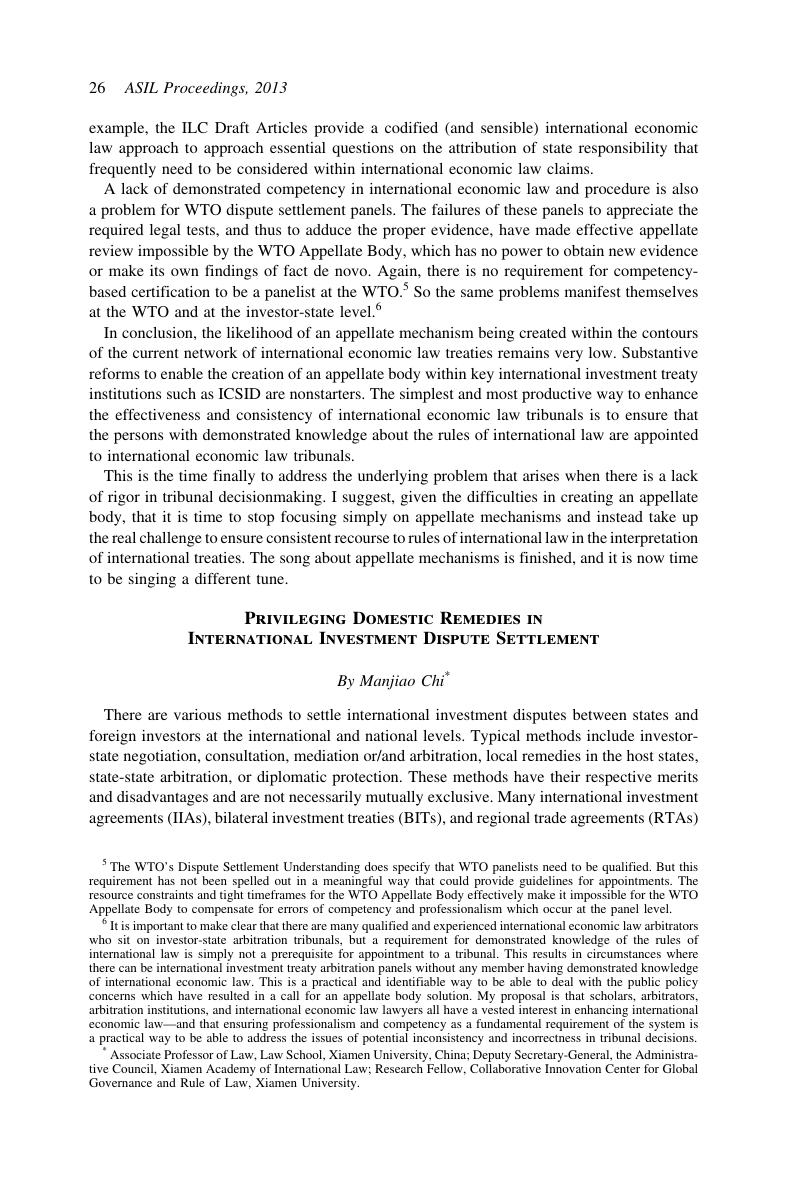Article contents
Privileging Domestic Remedies in International Investment Dispute Settlement
Published online by Cambridge University Press: 20 January 2017
Abstract

- Type
- Alternatives to Investor-State Arbitration in a Multipolar World
- Information
- Copyright
- Copyright © American Society of International Law 2014
References
1 See, e.g., Trakman, Leon E., Investor State Arbitration or Local Courts: Will Australia Set a New Trend? 46 J. World Trade 83 (2012)Google Scholar.
2 See, e.g., Schreuer, Christoph, Denunciation of the ICSID Convention and Consent to Arbitration, in The Backlash Against Investment Arbitration: Perceptions and Reality 353–68 (Waibel, Michael et al. eds., 2010)Google Scholar; United Nations Conference on Trade and Development (UNCTAD), Denunciation of the ICSID Convention: Impact on Investor-State Claims, IIA Issue Note No. 2, Dec. 2010.
3 See Philip Morris Asia Ltd. (Hong Kong) v. Australia, at http://www.pca-cpa.org/showpage.asp?pag_id=1494.
4 See Philip Morris Brand Sàrl (Switzerland), Philip Morris Products S.A. (Switzerland) & Abal Hermanos S.A. (Uruguay) v. Uruguay (ICSID Case No. ARB/10/7), at https://icsid.worldbank.org/ICSID/FrontServlet?requestType=GenCaseDtlsRH&actionVal=ListPending.
5 Luke Nottage, Investor-State Arbitration Policy and Practice After Philip Morris v. Australia, Japanese Law and the Asia-Pacific, http://blogs.usyd.edu.au/japaneselaw/2011/07/isa_claim.html.
6 Matthew C. Porterfield & Christopher R. Byrnes, Philip Morris v. Uruguay: Will Investor-State Arbitration Send Restrictions on Tobacco Marketing up in Smoke?, at http://www.iisd.org/itn/2011/07/12/philip-morris-v-uru-guay-will-investor-state-arbitration-send-restrictions-on-tobacco-marketing-up-in-smoke/.
7 See generally Franck, Susan, The Legitimacy Crisis in Investment Treaty Arbitration: Privatizing Public International Law Through Inconsistent Decisions, 73 Fordham L. Rev. 1521 (2005)Google Scholar.
8 See, e.g., Pia Eberhardt & Cecilia Olivet, Profiting from Injustice: How Law Firms, Arbitrators and Financiers Are Fuelling an Investment Arbitration Boom (Corporate Europe Observatory and the Transnational Institute), Nov. 2012, at http://www.tni.org/briefing/profiting-injustice.
9 The official website of the Ministry of Commerce of the People’s Republic of China provides an incomplete list of China’s BITs at http://tfs.mofcom.gov.cn/aarticle/Nocategory/201111/20111107819474.html, and a complete list of China’s FTAs at http://fta.mofcom.gov.cn/fta_qianshu.shtml.
10 Regarding the generations of Chinese BITs, see generally Elodie Dulac, The Emerging Third Generation of Chinese Investment Treaties, 7 Transnat’l Disp. Mgmt. (2010)Google Scholar; Dulac, Elodie, Chinese Investment Treaties: What Protection for Foreign Investment in China?, in Dispute Resolution in China 239 (Moser, Michael J. ed., 2012)Google Scholar; Axel Berger, China ‘s New Bilateral Investment Treaty Programme: Substance, Rational and Implications for International Investment Law Making, available at http://www.asil.org/files/ielconferencepapers/berger.pdf.
11 See, e.g., Agreement Between the Government of the People’s Republic of China and the Government of Malaysia Concerning the Reciprocal Encouragement and Protection of Investments art. 7, Nov. 21, 1988 (entered into force Mar. 31, 1990).
12 However, as suggested by the jurisdictional decision in Tza Yap Shum v. Republic of Peru (ICSID Case No. ARB/07/6), it is possible that, by broadly interpreting the ISA clause in China’s first-generation BITs, international arbitrators may expand their jurisdiction over the limit of compensation claims. The decisions of this case are available at https://icsid.worldbank.org/ICSID.
13 See, e.g., Agreement Between the Government of the People’s Republic of China and the Government of the Republic of France on the Reciprocal Promotion and Protection of Investments art. 7, Nov. 26, 2007 (entered into force Aug. 20, 2010). For the most recent example, see Agreement Between the Government of the People’s Republic of China and the Government of Canada for the Promotion and Reciprocal Protection of Investments art. 21, Sept. 9, 2012 (China-Canada BIT).
14 Law on Administrative Review of the People’s Republic of China art. 31, adopted at 9th meeting of the Standing Committee of the 9th National People’s Congress of the People’s Republic of China on Apr. 29, 1999 (effective Oct. 1, 1999).
15 For instance, the China-Canada BIT imposes a four-month period for administrative review. See China-Canada BIT art. 21. The China-Finland BIT imposes a three-month period for administrative review. See Protocol to the Agreement on the Encouragement and Reciprocal Protection of Investments Between the Government of Republic of Finland and the Government of the People’s Republic of China art. 9, Nov. 15, 2004 (entered into force Nov. 11, 2006).
- 1
- Cited by




